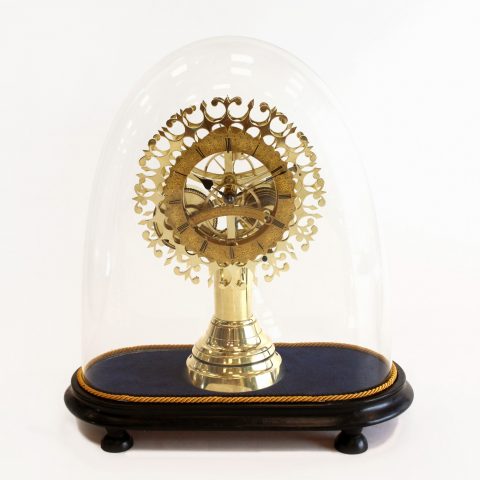Three-Month duration English Skeleton Clock

This is an exceptional long duration fusee timepiece skeleton clock by Franz de Raay, London dated c. 1860.
Personally, I have not seen anything else like this, nor in any horological reference book; Month-going examples are as rare as hen’s teeth, three-month examples are hardly seen at all. In Derek Roberts’ book, Skeleton Clocks Britain 1800-1914, he shows a couple of examples of year-going fusee clocks, but they have had to use multiple springs to generate the power required whereas this only has the one.
There are many unique aspects to this clock:
First and most obvious is its unique styling consisting of a flowerhead form raised on a substantial central pillar and turned foot. This is all mounted on a velvet lined ebonised base with its oval glass dome.
The dial, most unusually, is a solid chapter ring, fully engraved to display wax-filled numerals and floral detail. It is signed F de Raay, 72 Castle St. East, Oxford Street to a similarly engraved arched banner incorporating the winding hole. The complete dial benefits from it original gilding. I do not think I have seen another skeleton clock with a gilded dial.
The mechanism is fantastic in many respects. The thickness of the pierced plates used to produce the movement are 6mm, way in excess of the normal 4mm that you might expect. The wheel train is similarly finely engineered to produce a duration of three months running time on one complete wind. The winding of this clock is consistent with the majority of fusee movements we see in that complete winding from unwound takes the normal 33 half-turns. The long duration is achieved with the inclusion of an extra wheel and pinion, and to vary the wheel count so that the lower wheels and pinions have a higher-than-normal count. The wheels have five crossings. The escapement is a brocot dead-beat escapement using steel pallets set into a delicately formed curved frame.
Fine steel blued hands
The photos show the clock / movement prior to its servicing. It is to be overhauled and guaranteed for 3 years.
Franz de Raay is listed in Britten’s as working between 1856-1867.
- Height: 17 inches (46 cms)
- Width: 17 inches (43 cms)
- Depth: 8 inches (20cms)